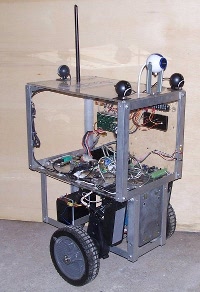What does it do?
Why a $500 robot and what does it do?
When I brought the robot to Linux World 2006 in Boston, the two most frequently asked questions were (1) What does it do? and (2) Why did you build it?
Why did I build the robot?
To answer the second question first, “Why did I build it?” Well, actually, that needs some history. I love robotics, I started building my first robot in the late 1970s. My first successful robot was modifying an old Mattel “Big Track” and using an RCA 1802 “Elf” computer to control it. The Elf computer was from a series of articles in (I think) Byte Magazine (Although it could have been popular electronics). I built the computer, I built the eprom burner, and programed it with toggle switches.
Fast forward a few years, my first job was Denning Mobile Robotics. I was an electronics engineer/technician at the time, myself and a couple others built a working robot hack as a development prototype while the main chassis was being developed. It was such a quick and dirty prototype, it got published in a few magazines hanging wires and 12V power supply and all. While the software people had fits because it was not as precise as they would have liked, it did allow them to develop software, and ironically prepared them for the real world of robotics: a purely inconsistent and unpredictable environment.
Since that time, for more than 20 years, I have been working in various companies in the 128 belt in Massachusetts High Tech community. Always keeping track of robotics and always keeping it in the back of my mind. During this time, I worked a lot of jobs as a hardware or software engineer. My highest position was CTO of a company.
After my dot com company went bust in 2001, I started consulting. During this time, I toyed with several projects. I worked on one proposal to create a small hardware/software product line, in doing so, I worked on some prototype hardware and software drivers. The proposal failed and the company wasn't interested, but never the less I had some stuff left over, hanging around.
In 2005, I had a discussion with someone who wanted to work on a vision algorithm for mobile robotics, but couldn't find a good platform. It seemed like the choice was small PIC based “roomba” type robots for a few hundred bucks, or several thousand for more substantial robots.
What bothered me about the bigger robots, is that they seemed little more than pretty shells over a few hundred dollars (retail) of computer parts. I couldn't recommend anything.
I looked around for various “do it yourself” projects. The OAP project looked interesting, (http://oap.sourceforge.net), but its target price is about $1500 and required a fairly complex mix of PC and PIC programming.
I decided I could build something that wasn't, at least in my opinion, out there. Like the quick and dirty prototype I built 20 years ago at Denning, I would design something that was fairly easy to build, fairly cheap, and used fairly easy to come by components.
I also wanted programming it to be easy. I wanted to keep the system to one set of development tools. I didn't want to have to have a PIC programmer and all the development issues involved. I wanted to be able to run the software on one or many computers. I wanted it to be a full computing environment with networking, applications, and so on. In short, I wanted it to be a working professional development platform at a hobby price.
So there you have it, while it is still a work in progress, it meets most of my criteria, and you can still build it for less than $5001.
What does it do?
What does it do? Well, frankly, nothing. Well, obviously, not nothing, it is a mobile robotics platform. It moves under control of a computer with feedback and motion control. It was designed not to accomplish a specific task, but to facilitate more advanced robotic development. With the children's“ride around” toy wheels and motors, it can accommodate some serious weight (60~80 lbs total). With the x86 based computer system, it can handle some good processing. With the networking it can work in conjunction with external computers and users. With the Linux OS, it can use a wealth of public research software as well as voice synthesis and mapping software. The possibilities are endless.
1$500 is a target price. It is assumed that you have access to most of the common components at reasonable prices and have at least some of the components already laying around. The more junk you have, the cheaper this thing is to build.

Status
Alas this is not my day job and I sometimes can't get to it as often as I'd like. If you want to get involved, that would be cool. Maybe I need a forum or blog system?